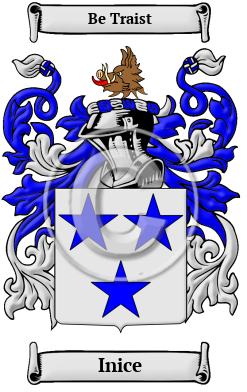| ![Show Contents]() Inice History, Family Crest & Coats of Arms Inice History, Family Crest & Coats of Arms
- Origins Available:
England
Scotland
Etymology of IniceWhat does the name Inice mean? The Inice surname in Scotland is said to derive from the name of the barony of Innes in Moray. As such, the surname belongs to the category of habitation names, which are derived from pre-existing names for towns, villages, parishes, or farmsteads. The place name Innes comes from the Gaelic "inis," meaning "island formed by two branches of a stream." 1 Early Origins of the Inice familyThe surname Inice was first found in Morayshire where they held a family seat from very ancient times. The Clan's progenitor is Berowaldus Flandrensis who, in 1153, obtained from King Malcolm IV a grant of lands in Innes, in the province of Elgin. 2 The original barony was an island formed by two branches of a stream. Berowaldus was supposedly a Fleming of quite high distinction. His grandson, Walter of Innes, had these lands confirmed to him in 1226 by King Alexander II of Scotland. Berowald continued to be a favorite first name within the Clan for some time, and this later became anglicized as Walter. Walter de Inneys was the first Chief of the Clan and held territorial control of the barony. His successor, William de Inays was forced to pledge his allegiance during King Edward I of England's brief conquest of Scotland in 1296. Scotland declared its independence at Arbroath in 1320, and it is from this point that the Innes Clan began to flourish; many branches developed with numerous Chieftains. Sir Alexander, the 9th Chief of the Clan, built the great tower of Kincairdy Castle, and King James IV was entertained there by Sir James, the 12th Chief of the Clan in 1490. In 1579, the Privy Council of Scotland officially recognized the Innes as a Clan under Robert, the 19th Chief of Innes. During the 1600's the Innes Clan played an important role in Scottish politics and Alexander Innes of Cockstoune, Sir Harie Innes, James Innes of Landysyde, Robert Innes, Chief of the Clan, Robert Innes of Murietown, Robert Innes of Blairtown, Robert Innes of Fortrose, were all members of Scotland's parliament. In 1554, the friction between the Innes Clan and the Dunbars reached its peak and was to continue for another thirty years. It had started with the intrusion of the Dunbars into Innes Clan territory. William Innes, the 15th Chief of the Clan, gathered eighty of his Clansmen and sacked the Priory of Pluscarden, and Alexander Dunbar narrowly escaped death on the alter steps of Elgin Cathedral. The feud finally ended with outside arbitration when it was agreed that no Dunbar should go east of the Cairn of Kilbuick and that no Innes could enter the town of Forres. Early History of the Inice familyThis web page shows only a small excerpt of our Inice research. Another 184 words (13 lines of text) covering the years 1370, 1396, 1398, 1406, 1407, 1414, 1650, 1651, 1652, 1655, 1662, 1670, 1677, 1680, 1681, 1684, 1690, 1691, 1715, 1721, 1736, 1738, 1744, 1767, 1805 and 1823 are included under the topic Early Inice History in all our PDF Extended History products and printed products wherever possible. Inice Spelling VariationsSpelling variations of this family name include: Innes, Innis, Innice, Inniss and others. Early Notables of the Inice familyOf note in the family at this time was John de Innes (c. 1370-1414), medieval Scottish churchman, received a bachelorate in civil law from the University of Paris by 1396 and in canon law by 1407, pursuing an ecclesiastical career, being Archdeacon of Caithness from 1396 until 1398, and Dean of Ross, from some point between 1396 and 1398 until 1407, gave up the latter position in that year, having been elected as Bishop of Moray sometime in late 1406, and receiving consecration from Pope Benedict XIII in either Italy or southern France in the following January, bishop for over seven...
Another 100 words (7 lines of text) are included under the topic Early Inice Notables in all our PDF Extended History products and printed products wherever possible. Migration of the Inice familySome of the first settlers of this family name or some of its variants were: James Innes, who arrived in Virginia in 1635; Alexander Innes, who settled in New England in 1651; Gilbert Innes, who came to East New Jersey in 1683.
The motto was originally a war cry or slogan. Mottoes first began to be shown with arms in the 14th and 15th centuries, but were not in general use until the 17th century. Thus the oldest coats of arms generally do not include a motto. Mottoes seldom form part of the grant of arms: Under most heraldic authorities, a motto is an optional component of the coat of arms, and can be added to or changed at will; many families have chosen not to display a motto.
Motto: Be Traist
Motto Translation: Be faithful.
- Reaney, P.H and R.M. Wilson, A Dictionary of English Surnames. London: Routledge, 1991. Print. (ISBN 0-415-05737-X)
- Black, George F., The Surnames of Scotland Their Origin, Meaning and History. New York: New York Public Library, 1946. Print. (ISBN 0-87104-172-3)
 |

